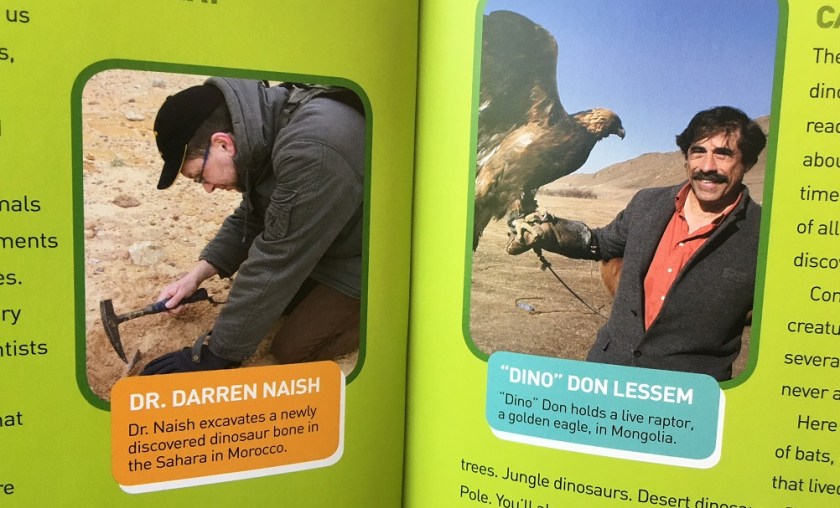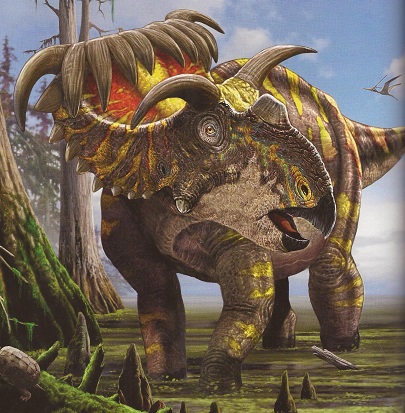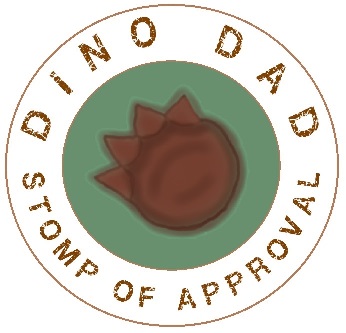I’ve held off on dinosaur encyclopedias and other such books so far while I get the hang of this whole blogging business, focusing instead on lighter fare to establish that yes, this is indeed a dad blog written with parents of young children in mind. But all young dino lovers eventually want to learn more about these fantastic beasts, and the Ultimate Dinopedia has dinosaur facts galore crammed into its pages. A decently sized volume, it is authored by “Dino Don” Lessem, and illustrated by Franco Tempesta, with Dr. Darren Naish (of Tetrapod Zoology & TetZooCon fame) providing professional advice. (Naish also advised on Build Your Own Dinosaurs Sticker Book and 199 Dinosaurs and Other Prehistoric Animals.) Dinosaur fans may be familiar with Dino Don; I certainly remember his regular column in “Highlights for Kids” quite fondly. I even wrote him a letter once, and got a reply back, though sadly I think the letter got lost somewhere in the intervening years.
I was pleasantly surprised by the relatively good overall quality of the book. So many of these dinosaur encyclopedias, even those produced by major, respectable publishers, feel like quick cash grabs that slap together a bunch of oft-repeated dinosaur “facts”, often of dubious merit. But with Don Lessem at the helm (advised by Darren Naish to boot), little can go wrong, and indeed, of the few things I found to criticize about the book, most consisted of little more than sloppy editing.

The illustrations particularly impressed me. Almost all the artwork seems consistent with current views on the life appearances of the species depicted. The maniraptorans especially generally all possess the right types and configurations of feathers, no mean feat in popular dinosaur literature, even those that delve into the bird connection. I like Tempesta’s use of color, which generally manages to avoid the flat, boring greys and browns that so many illustrators get stuck on, without swinging the pendulum too far the other way into unrealistic riots of bizarre colors. Take this Kosmoceratops, for example. It has a nice natural looking base color, but with some splashes of bright colors appropriate to such an inherently showy animal.

We also see Psittacosaurus in its quilly glory (page 81), though the reader might guess this came out before Mark Hallet’s apparently “definitive” take on the genus. I also appreciated the updated Tsintaosaurus (page 111), which has the proper crest on its head, rather than the classic “unicorn spike” (or the rather, erm, phallic-looking version of the same, although read on). While the idea of a quadrupedal Spinosaurus remains somewhat controversial, the author depicts it well on page 145, showing the dinosaur resting on its knuckles rather than with its palms on the ground. It’s a small touch, but it speaks to the artist’s care for detail in this picture. If Spinosaurus was indeed a quadruped, this is how it would have walked.

I do have issues with a few illustrations. The first concerns the image for Gastonia on page 66. Now the Gastonia itself looks fine, but the nekkid raptor in the background confuses me. Why, when so many other theropods are properly feathered, does this appear here? Perhaps it’s an older image that got recycled for this book, though I have a feeling it’s one of the few instances of pop culture influencing the reconstructions rather than the science. My second issue feels perhaps somewhat nitpicky, but I was disappointed by the framing of the Acrocanthosaurus image on page 148. Its very name means “high spined lizard”, in reference to its prominent ridgeback look, but the illustration is nothing more than a closeup of the creature’s head. I would’ve preferred an illustration that show more of the body, so as to better depict the differences between it and other relatives. The final image I feel I must criticize is the Scansoripoteryx on page 179, though I feel this may have been an editing goof rather than an actual mistake on the part of the illustrator. Indeed, the image depicts a very fine generic raptor dinosaur, but it looks nothing like Scansoripoteryx, which should look more similar to the bat-winged dinosaur Yi qi on page 196.

The text supplies a sufficient amount of information to keep any young dinosaur lover entertained for quite some time. Some parts may sensationalize things a bit, and other gloss over more nuanced interpretations of the data, but for the most part, everything seems on the level. I really appreciated that a significant portion of the book’s opening covers the basics of paleontology itself. I find that a good discussion of “how we know what we know” really helps these sorts of encyclopedias feel like more than just some sort of stamp collection. Lessem even devotes a two-page spread to various famous paleontologists. I only wish he’d taken the space to introduce us to more!

I did find a few editing errors, however. The text for Muttaburrasaurus (pg 97) bears a subtitle that reads “Nest Raider?”, which is explained nowhere in the text and does not seem to match this plant-eating animal. However, when we get to Aucasaurus on page 131, we see the same caption again; this time apparently in its proper place, with speculation on its predatory habits.

I’ve already mentioned the possible Scansoripoteryx editing error, and a similar one occurs in the Tsintaosaurus entry. The text describes the classic “unicorn horn” characteristic of older depictions of Tsintaosaurus, despite the accompanying image clearly depicting the proper crest recently found on more complete specimens.

I also noted that Dracorex and Pachycephalosaurus each get seperate entries in the book, despite the general consensus that the former is merely a juvenile of the latter (though in fairness, the book does admit this, so I guess it’s fine). The book does mistakenly claim that “Dracorex” was named for Draco Malfoy of Harry Potter fame, though that’s not really true. The Harry Potter connection comes through its full name, “Dracorex hogwartsia”, or “dragon king of Hogwarts”.
Now, I may have compained about a few things in this review, but considering the sheer number of entries in this book, that’s small potatoes for a popular book of this size. The Ultimate Dinopedia is one of the better books of its caliber out there on bookshelves right now. If your kid is the type that loves to sit and absorb as much dinosaur related information as possible, this is the book for you! Excellent illustrations, quality information, and a large volume jam-packed with nearly a hundred species, I guarantee it will occupy any readers for quite some time! This volume definitely receives the official Dino Dad Stomp of Approval! Special thanks to my father in law who picked up this book for me! You can find it wherever books are sold, including here on Amazon.

For more on Dino Don, check out his website here, though click here if you want to listen to one of the best theme songs ever. Franco Tempesta appears to be the go-to guy for National Geographic’s dinosaur books these days; you can view his portfolio at his website here. Darren Naish is probably the most internet-famous paleontologist of all time, and heads something of a small media empire with his various Tetrapod Zoology projects. Click here to visit the current iteration of his main blog, and click here to listen to or download the podcast from your browser. You can also check out his Tetrapod Zoology group on Facebook, and the podcast is available through iTunes as well.
EDIT:
If I’d known the Lessemsauridae family of dinosaurs would be making the news only a few weeks later, I might have delayed this post and emphasized the inclusion of Lessemsaurus itself! Author Dino Don happens to be the namesake of this critter, which in turn lends its name to its immediate family of “prosauropod” dinosaurs. A recent study on Lessemsaurs has cast some light on the development of gigantism among sauropod (long-neck) dinosaurs. The online store and blog Everything Dinosaur has a good write-up on it if you’re interested!



I found your review in looking for an answer to this question: why are some of the scale silhouettes so _ludicrously_ wrong? The most egregious example I’ve noticed so far is Ankylosaurus (Page 73). In the silhouette, the human looks to be less than half the height of the ankylosaur’s back leg, and roughly the same height as the width of the tail club! That’s way too big, right?
LikeLike
Oof, yeah, I had glossed over those when I last looked at this, but yeah, that Ankylosaur is particularly bad! 0_0
I think I was may have still been reeling from the even worse size charts in Dinosaur ABC, so I may have let these ones slide on accident!
https://dinodadreviews.com/2018/07/05/dinosaur-abc-priddy-books/
LikeLike